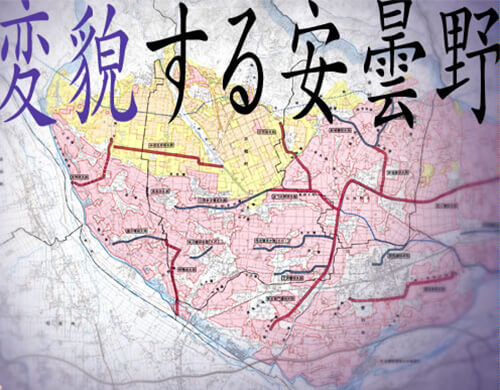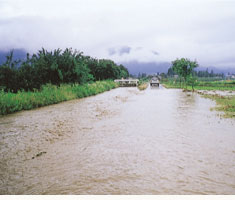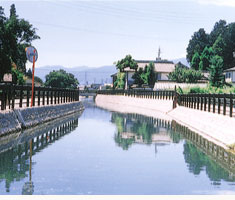
As Japan’s high economic growth period began around 1955, the nation’s agriculture and agricultural villages also underwent a massive change. Manpower in the agricultural villages was absorbed into urban areas, and varieties of agricultural products changed drastically along with the development of distribution systems.
Even such bases of subsistence as rivers, water, and land, were incorporated into the system of the economic development. Urban values, based on the principle of a free economy, came to dominate the society, replacing long-established morals and social order in rural communities as well.
Azumino was no exception.
As expressways were constructed, the areas around the Azumino interchange and along the extensive agricultural roads, began to be developed as commercial areas, and many new residences were developed. In other words, conventional land-use has changed dramatically over the last 40 to 50 years. Some of the major changes are:
Thus, means and ways of water-use have also changed drastically.
The devastation of mountain forests in particular has accelerated rainwater runoff. Forests have not been thinned regularly, formed thick canopies where sunlight cannot reach the ground surface, thus preventing the growth of under bush. As a result, the fertile and spongy surface of the mountain forests which has the capacity to retain great amounts of water is not being well maintained. Further, as paddy farms decrease, the temporary water storage capacity in times of precipitation is also decreasing. Subsequently, the pattern of runoff due to rainfall has changed: thus, the runoff ratio is gradually increasing.
These days, when it rains the water flows down faster and in larger amount than it used to.
The conventional drainage capacity has been disrupted, and that tends to threaten farmlands and farmers’ livelihoods.
The region originally had no drainage channels. Therefore, each time it rained heavily, rainwater would overflow from the irrigation canals and caused damage. This area was exceptional in Japan where the Kurosawa River, Class A river, flowed into an irrigation canal at the end, which resulted in damages of vast areas due to flooding.
For this reason, as drainage projects both national and prefectural are underway as well as improvement of Kurosawa dam and Yorozui River which is promoted by Nagano Prefecture. Originally, any rainwater in this region was drained off via the Yorozui River and Jikkasegi into the Karasu and Sai Rivers due to the bowl-shape of the entire zone. Due to these projects, the precipitation in this area will be drained off into the Azusa River as well, in order to disperse the drained water into the different river for the first time in history.
Admirable predecessors developed land and water resources in this region over the span of 1,000 years. Conflicts over these resources have not yet ended. Many efforts are still being made just as in the old days under the new name of “agriculture and rural development” by national, prefectural, and municipal governments. However, no matter how much cutting-edge technology we may apply, these projects are not almighty. Continuous operation and maintenance of agricultural water-use facilities as well as their timely and appropriate renovation will always be essential.
Land Improvement Districts have so far played the essential role for 1,000 years.
It is our hope that these Land Improvement Districts, which are akin to a public entity, will strengthen the social systems of towns and villages and play a key role in managing land and water resources in Azumino.
In any case, perhaps the most important task is the establishment of a land-use plan by and for the inhabitants of this region for which they take the consequences. There will also likely to be more requests for the establishment of agricultural production bases that emphasize harmony with animals and plants, reduction of agricultural chemical use and control of fertilizer use.
In Azumino, there are some of Japan’s most beautiful agricultural landscapes, nature-friendly types of development are strongly requested. However, this cannot be achieved only by farmers, Land Improvement Districts, or governments. If the beautiful rural scenery of Azumino is everybody’s common heritage, then they must work together to protect the region’s agriculture. Azumino which was developed through agriculture is bound to fall into a crisis when people fail to remember what agriculture truly means.

Water Overflowing from an Irrigation Canal (June 1999)

Jikkasegi Rehabilitated in Consideration of Local Scenery